Annotated Bibliography: Dental Implants in Healthcare 7
VerifiedAdded on 2022/08/22
|9
|2282
|23
Annotated Bibliography
AI Summary
This annotated bibliography examines five articles related to the success and failure of dental implants. The articles cover various aspects, including the importance of oral hygiene in preventing peri-implantitis, the impact of risk factors like diabetes and smoking on implant survival, and the success rates of implants in elderly patients. The research also delves into mechanical risk factors such as bruxism and their correlation with implant failure, as well as the identification of cluster behavior in patients experiencing multiple implant failures. The studies highlight the significance of patient-specific risk assessment, careful implant placement, and the implementation of preventive strategies to improve the long-term success of dental implants.

Running head: HEALTHCARE 1
Dental biomaterials
Name of the Student
Name of the University
Author Note
Dental biomaterials
Name of the Student
Name of the University
Author Note
Paraphrase This Document
Need a fresh take? Get an instant paraphrase of this document with our AI Paraphraser
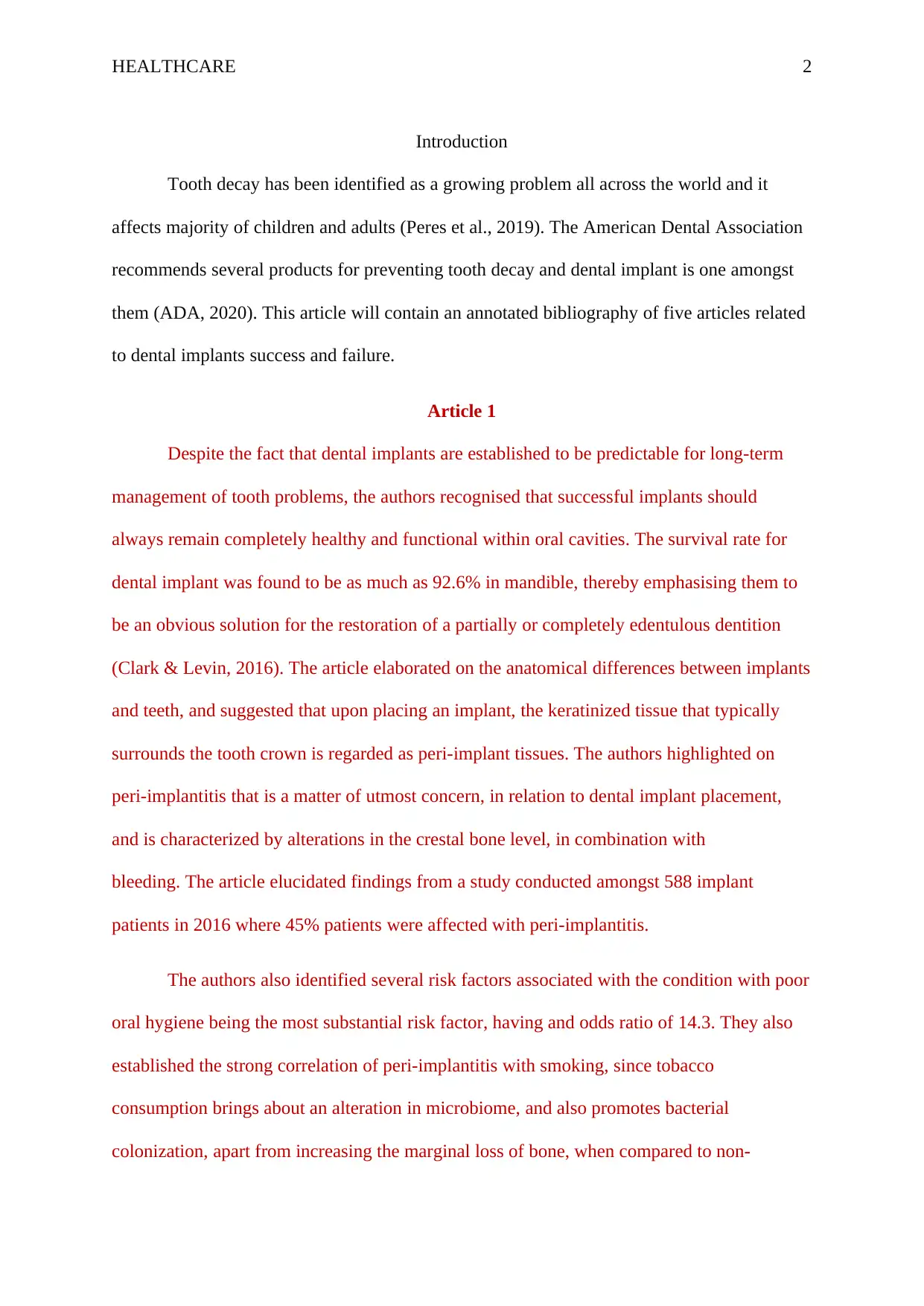
HEALTHCARE 2
Introduction
Tooth decay has been identified as a growing problem all across the world and it
affects majority of children and adults (Peres et al., 2019). The American Dental Association
recommends several products for preventing tooth decay and dental implant is one amongst
them (ADA, 2020). This article will contain an annotated bibliography of five articles related
to dental implants success and failure.
Article 1
Despite the fact that dental implants are established to be predictable for long-term
management of tooth problems, the authors recognised that successful implants should
always remain completely healthy and functional within oral cavities. The survival rate for
dental implant was found to be as much as 92.6% in mandible, thereby emphasising them to
be an obvious solution for the restoration of a partially or completely edentulous dentition
(Clark & Levin, 2016). The article elaborated on the anatomical differences between implants
and teeth, and suggested that upon placing an implant, the keratinized tissue that typically
surrounds the tooth crown is regarded as peri-implant tissues. The authors highlighted on
peri-implantitis that is a matter of utmost concern, in relation to dental implant placement,
and is characterized by alterations in the crestal bone level, in combination with
bleeding. The article elucidated findings from a study conducted amongst 588 implant
patients in 2016 where 45% patients were affected with peri-implantitis.
The authors also identified several risk factors associated with the condition with poor
oral hygiene being the most substantial risk factor, having and odds ratio of 14.3. They also
established the strong correlation of peri-implantitis with smoking, since tobacco
consumption brings about an alteration in microbiome, and also promotes bacterial
colonization, apart from increasing the marginal loss of bone, when compared to non-
Introduction
Tooth decay has been identified as a growing problem all across the world and it
affects majority of children and adults (Peres et al., 2019). The American Dental Association
recommends several products for preventing tooth decay and dental implant is one amongst
them (ADA, 2020). This article will contain an annotated bibliography of five articles related
to dental implants success and failure.
Article 1
Despite the fact that dental implants are established to be predictable for long-term
management of tooth problems, the authors recognised that successful implants should
always remain completely healthy and functional within oral cavities. The survival rate for
dental implant was found to be as much as 92.6% in mandible, thereby emphasising them to
be an obvious solution for the restoration of a partially or completely edentulous dentition
(Clark & Levin, 2016). The article elaborated on the anatomical differences between implants
and teeth, and suggested that upon placing an implant, the keratinized tissue that typically
surrounds the tooth crown is regarded as peri-implant tissues. The authors highlighted on
peri-implantitis that is a matter of utmost concern, in relation to dental implant placement,
and is characterized by alterations in the crestal bone level, in combination with
bleeding. The article elucidated findings from a study conducted amongst 588 implant
patients in 2016 where 45% patients were affected with peri-implantitis.
The authors also identified several risk factors associated with the condition with poor
oral hygiene being the most substantial risk factor, having and odds ratio of 14.3. They also
established the strong correlation of peri-implantitis with smoking, since tobacco
consumption brings about an alteration in microbiome, and also promotes bacterial
colonization, apart from increasing the marginal loss of bone, when compared to non-
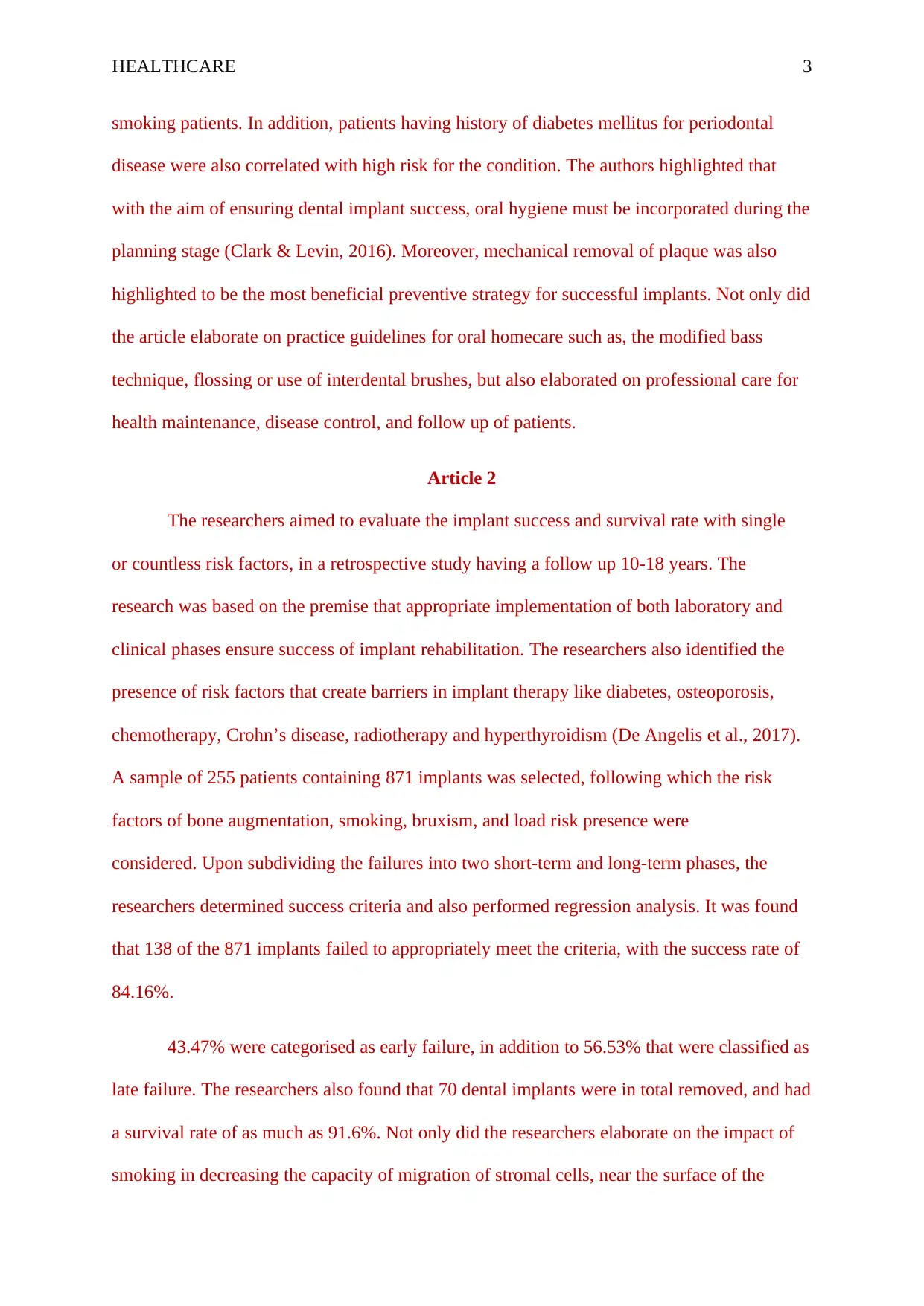
HEALTHCARE 3
smoking patients. In addition, patients having history of diabetes mellitus for periodontal
disease were also correlated with high risk for the condition. The authors highlighted that
with the aim of ensuring dental implant success, oral hygiene must be incorporated during the
planning stage (Clark & Levin, 2016). Moreover, mechanical removal of plaque was also
highlighted to be the most beneficial preventive strategy for successful implants. Not only did
the article elaborate on practice guidelines for oral homecare such as, the modified bass
technique, flossing or use of interdental brushes, but also elaborated on professional care for
health maintenance, disease control, and follow up of patients.
Article 2
The researchers aimed to evaluate the implant success and survival rate with single
or countless risk factors, in a retrospective study having a follow up 10-18 years. The
research was based on the premise that appropriate implementation of both laboratory and
clinical phases ensure success of implant rehabilitation. The researchers also identified the
presence of risk factors that create barriers in implant therapy like diabetes, osteoporosis,
chemotherapy, Crohn’s disease, radiotherapy and hyperthyroidism (De Angelis et al., 2017).
A sample of 255 patients containing 871 implants was selected, following which the risk
factors of bone augmentation, smoking, bruxism, and load risk presence were
considered. Upon subdividing the failures into two short-term and long-term phases, the
researchers determined success criteria and also performed regression analysis. It was found
that 138 of the 871 implants failed to appropriately meet the criteria, with the success rate of
84.16%.
43.47% were categorised as early failure, in addition to 56.53% that were classified as
late failure. The researchers also found that 70 dental implants were in total removed, and had
a survival rate of as much as 91.6%. Not only did the researchers elaborate on the impact of
smoking in decreasing the capacity of migration of stromal cells, near the surface of the
smoking patients. In addition, patients having history of diabetes mellitus for periodontal
disease were also correlated with high risk for the condition. The authors highlighted that
with the aim of ensuring dental implant success, oral hygiene must be incorporated during the
planning stage (Clark & Levin, 2016). Moreover, mechanical removal of plaque was also
highlighted to be the most beneficial preventive strategy for successful implants. Not only did
the article elaborate on practice guidelines for oral homecare such as, the modified bass
technique, flossing or use of interdental brushes, but also elaborated on professional care for
health maintenance, disease control, and follow up of patients.
Article 2
The researchers aimed to evaluate the implant success and survival rate with single
or countless risk factors, in a retrospective study having a follow up 10-18 years. The
research was based on the premise that appropriate implementation of both laboratory and
clinical phases ensure success of implant rehabilitation. The researchers also identified the
presence of risk factors that create barriers in implant therapy like diabetes, osteoporosis,
chemotherapy, Crohn’s disease, radiotherapy and hyperthyroidism (De Angelis et al., 2017).
A sample of 255 patients containing 871 implants was selected, following which the risk
factors of bone augmentation, smoking, bruxism, and load risk presence were
considered. Upon subdividing the failures into two short-term and long-term phases, the
researchers determined success criteria and also performed regression analysis. It was found
that 138 of the 871 implants failed to appropriately meet the criteria, with the success rate of
84.16%.
43.47% were categorised as early failure, in addition to 56.53% that were classified as
late failure. The researchers also found that 70 dental implants were in total removed, and had
a survival rate of as much as 91.6%. Not only did the researchers elaborate on the impact of
smoking in decreasing the capacity of migration of stromal cells, near the surface of the
⊘ This is a preview!⊘
Do you want full access?
Subscribe today to unlock all pages.

Trusted by 1+ million students worldwide
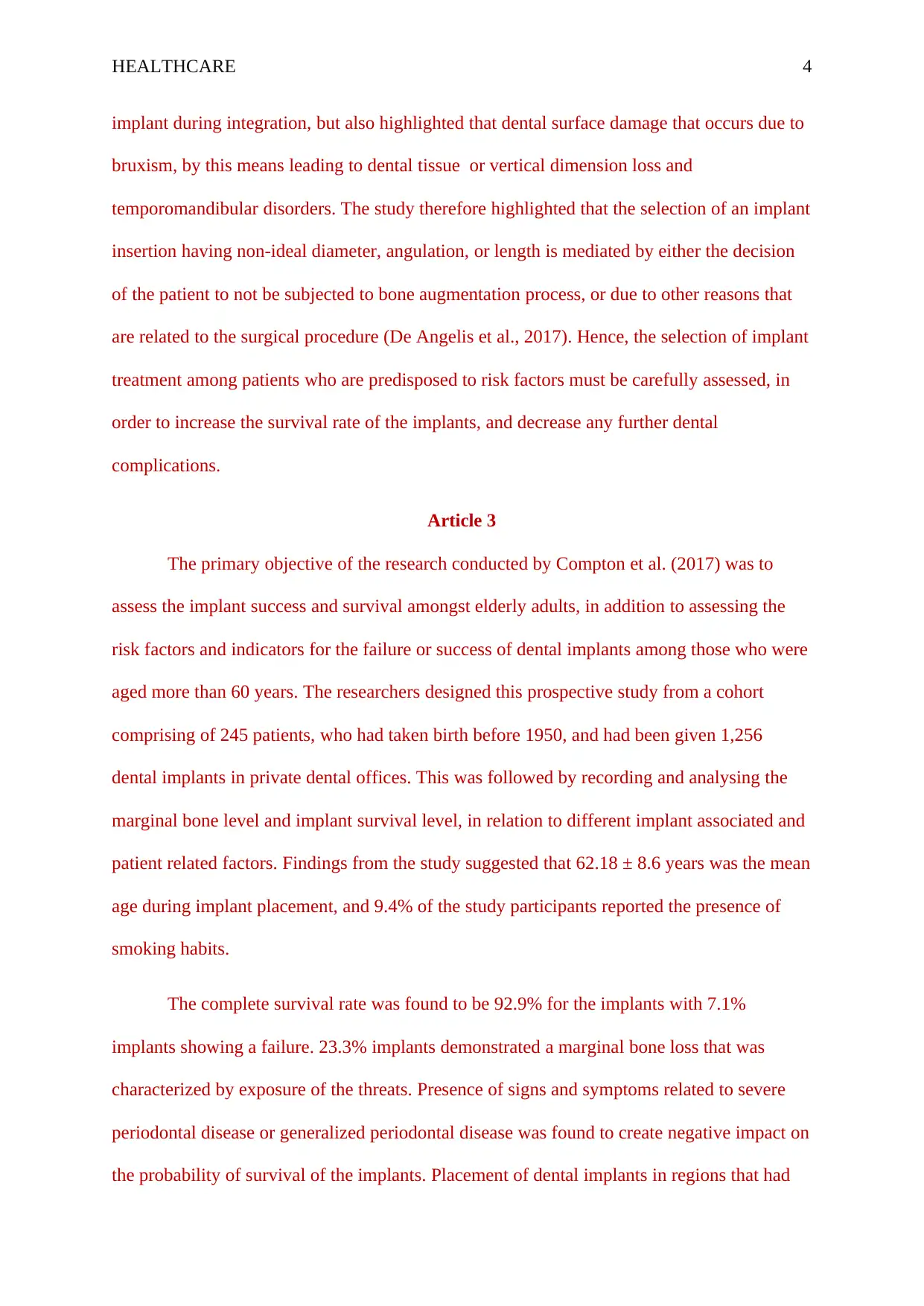
HEALTHCARE 4
implant during integration, but also highlighted that dental surface damage that occurs due to
bruxism, by this means leading to dental tissue or vertical dimension loss and
temporomandibular disorders. The study therefore highlighted that the selection of an implant
insertion having non-ideal diameter, angulation, or length is mediated by either the decision
of the patient to not be subjected to bone augmentation process, or due to other reasons that
are related to the surgical procedure (De Angelis et al., 2017). Hence, the selection of implant
treatment among patients who are predisposed to risk factors must be carefully assessed, in
order to increase the survival rate of the implants, and decrease any further dental
complications.
Article 3
The primary objective of the research conducted by Compton et al. (2017) was to
assess the implant success and survival amongst elderly adults, in addition to assessing the
risk factors and indicators for the failure or success of dental implants among those who were
aged more than 60 years. The researchers designed this prospective study from a cohort
comprising of 245 patients, who had taken birth before 1950, and had been given 1,256
dental implants in private dental offices. This was followed by recording and analysing the
marginal bone level and implant survival level, in relation to different implant associated and
patient related factors. Findings from the study suggested that 62.18 ± 8.6 years was the mean
age during implant placement, and 9.4% of the study participants reported the presence of
smoking habits.
The complete survival rate was found to be 92.9% for the implants with 7.1%
implants showing a failure. 23.3% implants demonstrated a marginal bone loss that was
characterized by exposure of the threats. Presence of signs and symptoms related to severe
periodontal disease or generalized periodontal disease was found to create negative impact on
the probability of survival of the implants. Placement of dental implants in regions that had
implant during integration, but also highlighted that dental surface damage that occurs due to
bruxism, by this means leading to dental tissue or vertical dimension loss and
temporomandibular disorders. The study therefore highlighted that the selection of an implant
insertion having non-ideal diameter, angulation, or length is mediated by either the decision
of the patient to not be subjected to bone augmentation process, or due to other reasons that
are related to the surgical procedure (De Angelis et al., 2017). Hence, the selection of implant
treatment among patients who are predisposed to risk factors must be carefully assessed, in
order to increase the survival rate of the implants, and decrease any further dental
complications.
Article 3
The primary objective of the research conducted by Compton et al. (2017) was to
assess the implant success and survival amongst elderly adults, in addition to assessing the
risk factors and indicators for the failure or success of dental implants among those who were
aged more than 60 years. The researchers designed this prospective study from a cohort
comprising of 245 patients, who had taken birth before 1950, and had been given 1,256
dental implants in private dental offices. This was followed by recording and analysing the
marginal bone level and implant survival level, in relation to different implant associated and
patient related factors. Findings from the study suggested that 62.18 ± 8.6 years was the mean
age during implant placement, and 9.4% of the study participants reported the presence of
smoking habits.
The complete survival rate was found to be 92.9% for the implants with 7.1%
implants showing a failure. 23.3% implants demonstrated a marginal bone loss that was
characterized by exposure of the threats. Presence of signs and symptoms related to severe
periodontal disease or generalized periodontal disease was found to create negative impact on
the probability of survival of the implants. Placement of dental implants in regions that had
Paraphrase This Document
Need a fresh take? Get an instant paraphrase of this document with our AI Paraphraser
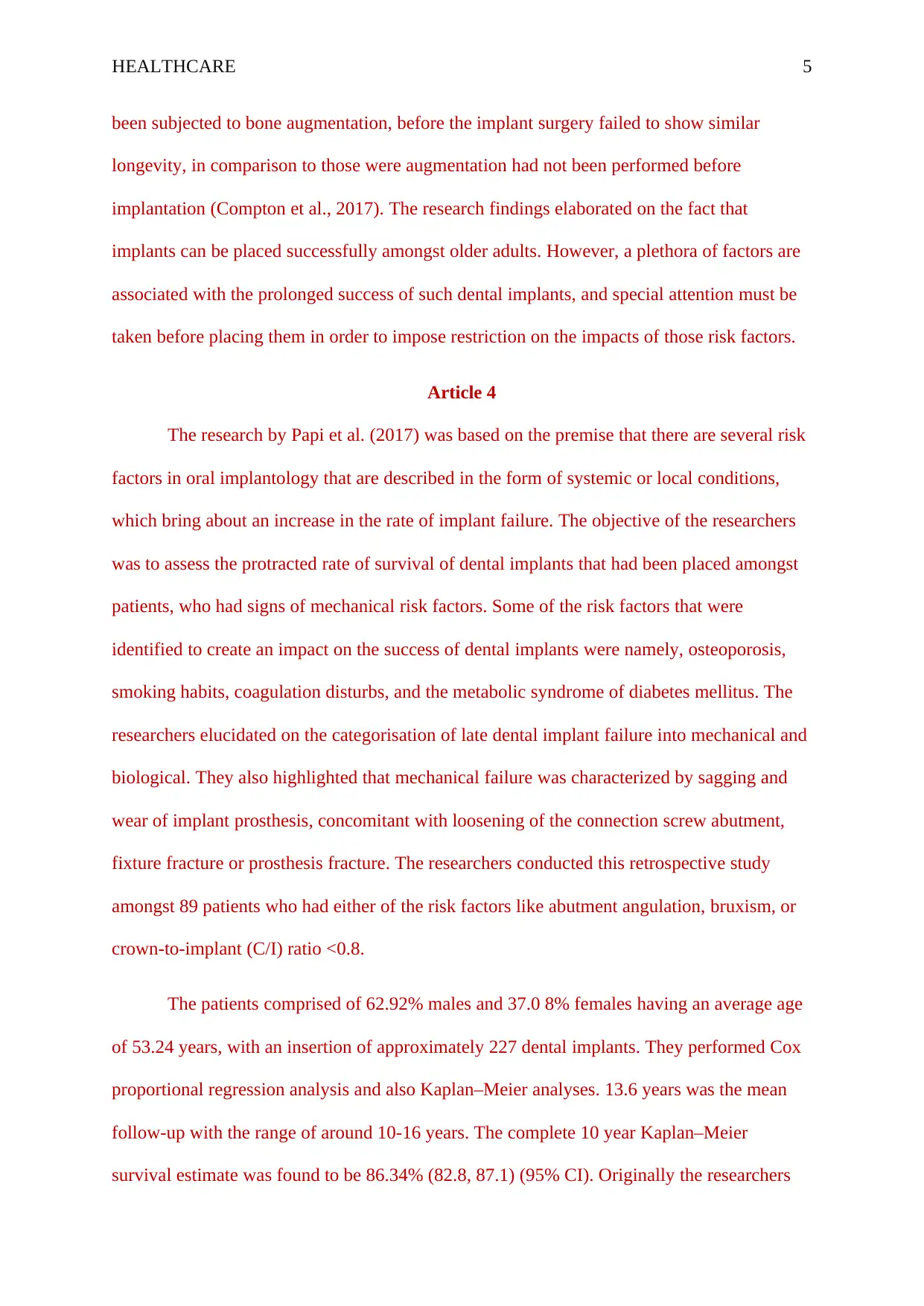
HEALTHCARE 5
been subjected to bone augmentation, before the implant surgery failed to show similar
longevity, in comparison to those were augmentation had not been performed before
implantation (Compton et al., 2017). The research findings elaborated on the fact that
implants can be placed successfully amongst older adults. However, a plethora of factors are
associated with the prolonged success of such dental implants, and special attention must be
taken before placing them in order to impose restriction on the impacts of those risk factors.
Article 4
The research by Papi et al. (2017) was based on the premise that there are several risk
factors in oral implantology that are described in the form of systemic or local conditions,
which bring about an increase in the rate of implant failure. The objective of the researchers
was to assess the protracted rate of survival of dental implants that had been placed amongst
patients, who had signs of mechanical risk factors. Some of the risk factors that were
identified to create an impact on the success of dental implants were namely, osteoporosis,
smoking habits, coagulation disturbs, and the metabolic syndrome of diabetes mellitus. The
researchers elucidated on the categorisation of late dental implant failure into mechanical and
biological. They also highlighted that mechanical failure was characterized by sagging and
wear of implant prosthesis, concomitant with loosening of the connection screw abutment,
fixture fracture or prosthesis fracture. The researchers conducted this retrospective study
amongst 89 patients who had either of the risk factors like abutment angulation, bruxism, or
crown-to-implant (C/I) ratio <0.8.
The patients comprised of 62.92% males and 37.0 8% females having an average age
of 53.24 years, with an insertion of approximately 227 dental implants. They performed Cox
proportional regression analysis and also Kaplan–Meier analyses. 13.6 years was the mean
follow-up with the range of around 10-16 years. The complete 10 year Kaplan–Meier
survival estimate was found to be 86.34% (82.8, 87.1) (95% CI). Originally the researchers
been subjected to bone augmentation, before the implant surgery failed to show similar
longevity, in comparison to those were augmentation had not been performed before
implantation (Compton et al., 2017). The research findings elaborated on the fact that
implants can be placed successfully amongst older adults. However, a plethora of factors are
associated with the prolonged success of such dental implants, and special attention must be
taken before placing them in order to impose restriction on the impacts of those risk factors.
Article 4
The research by Papi et al. (2017) was based on the premise that there are several risk
factors in oral implantology that are described in the form of systemic or local conditions,
which bring about an increase in the rate of implant failure. The objective of the researchers
was to assess the protracted rate of survival of dental implants that had been placed amongst
patients, who had signs of mechanical risk factors. Some of the risk factors that were
identified to create an impact on the success of dental implants were namely, osteoporosis,
smoking habits, coagulation disturbs, and the metabolic syndrome of diabetes mellitus. The
researchers elucidated on the categorisation of late dental implant failure into mechanical and
biological. They also highlighted that mechanical failure was characterized by sagging and
wear of implant prosthesis, concomitant with loosening of the connection screw abutment,
fixture fracture or prosthesis fracture. The researchers conducted this retrospective study
amongst 89 patients who had either of the risk factors like abutment angulation, bruxism, or
crown-to-implant (C/I) ratio <0.8.
The patients comprised of 62.92% males and 37.0 8% females having an average age
of 53.24 years, with an insertion of approximately 227 dental implants. They performed Cox
proportional regression analysis and also Kaplan–Meier analyses. 13.6 years was the mean
follow-up with the range of around 10-16 years. The complete 10 year Kaplan–Meier
survival estimate was found to be 86.34% (82.8, 87.1) (95% CI). Originally the researchers
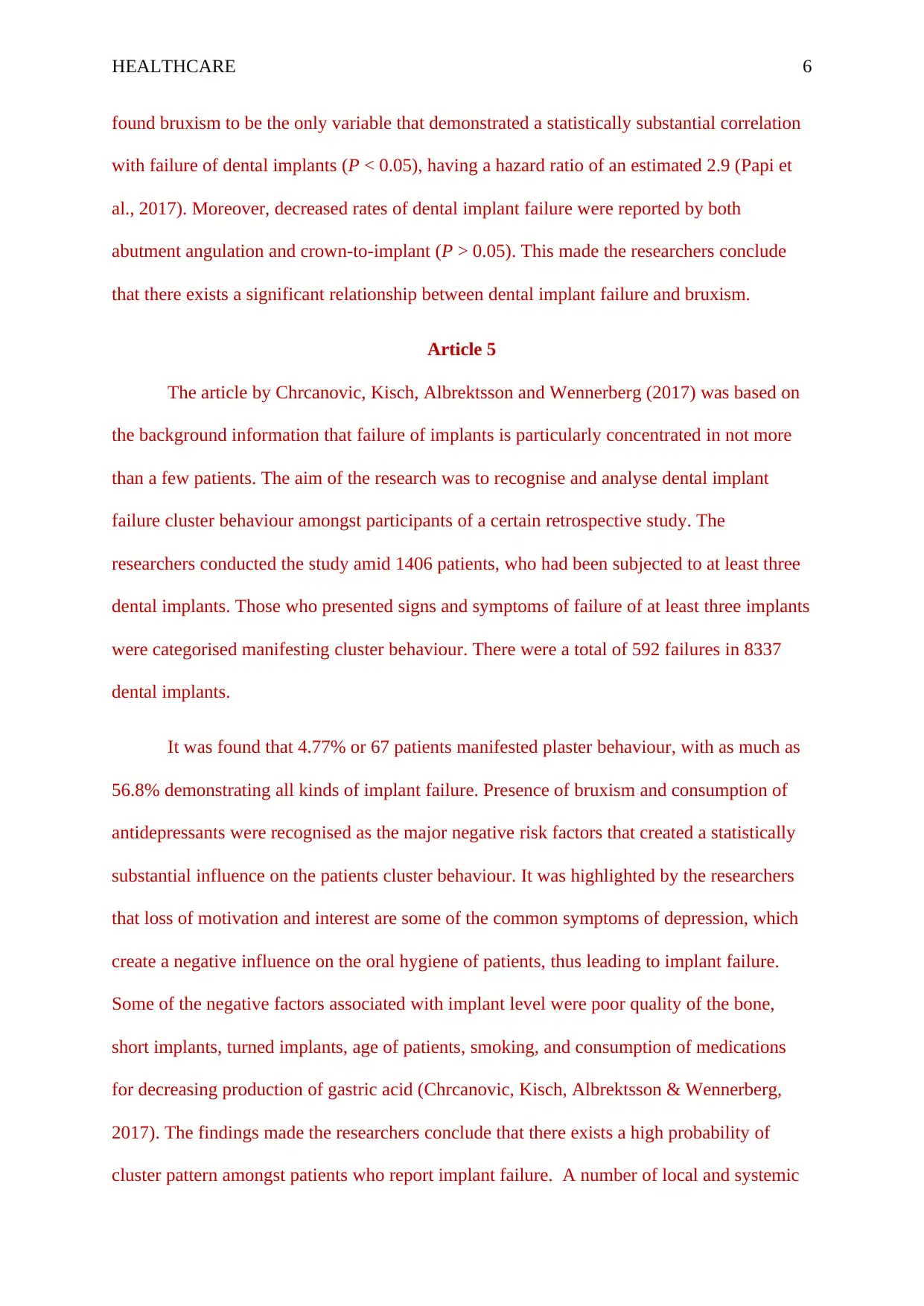
HEALTHCARE 6
found bruxism to be the only variable that demonstrated a statistically substantial correlation
with failure of dental implants (P < 0.05), having a hazard ratio of an estimated 2.9 (Papi et
al., 2017). Moreover, decreased rates of dental implant failure were reported by both
abutment angulation and crown-to-implant (P > 0.05). This made the researchers conclude
that there exists a significant relationship between dental implant failure and bruxism.
Article 5
The article by Chrcanovic, Kisch, Albrektsson and Wennerberg (2017) was based on
the background information that failure of implants is particularly concentrated in not more
than a few patients. The aim of the research was to recognise and analyse dental implant
failure cluster behaviour amongst participants of a certain retrospective study. The
researchers conducted the study amid 1406 patients, who had been subjected to at least three
dental implants. Those who presented signs and symptoms of failure of at least three implants
were categorised manifesting cluster behaviour. There were a total of 592 failures in 8337
dental implants.
It was found that 4.77% or 67 patients manifested plaster behaviour, with as much as
56.8% demonstrating all kinds of implant failure. Presence of bruxism and consumption of
antidepressants were recognised as the major negative risk factors that created a statistically
substantial influence on the patients cluster behaviour. It was highlighted by the researchers
that loss of motivation and interest are some of the common symptoms of depression, which
create a negative influence on the oral hygiene of patients, thus leading to implant failure.
Some of the negative factors associated with implant level were poor quality of the bone,
short implants, turned implants, age of patients, smoking, and consumption of medications
for decreasing production of gastric acid (Chrcanovic, Kisch, Albrektsson & Wennerberg,
2017). The findings made the researchers conclude that there exists a high probability of
cluster pattern amongst patients who report implant failure. A number of local and systemic
found bruxism to be the only variable that demonstrated a statistically substantial correlation
with failure of dental implants (P < 0.05), having a hazard ratio of an estimated 2.9 (Papi et
al., 2017). Moreover, decreased rates of dental implant failure were reported by both
abutment angulation and crown-to-implant (P > 0.05). This made the researchers conclude
that there exists a significant relationship between dental implant failure and bruxism.
Article 5
The article by Chrcanovic, Kisch, Albrektsson and Wennerberg (2017) was based on
the background information that failure of implants is particularly concentrated in not more
than a few patients. The aim of the research was to recognise and analyse dental implant
failure cluster behaviour amongst participants of a certain retrospective study. The
researchers conducted the study amid 1406 patients, who had been subjected to at least three
dental implants. Those who presented signs and symptoms of failure of at least three implants
were categorised manifesting cluster behaviour. There were a total of 592 failures in 8337
dental implants.
It was found that 4.77% or 67 patients manifested plaster behaviour, with as much as
56.8% demonstrating all kinds of implant failure. Presence of bruxism and consumption of
antidepressants were recognised as the major negative risk factors that created a statistically
substantial influence on the patients cluster behaviour. It was highlighted by the researchers
that loss of motivation and interest are some of the common symptoms of depression, which
create a negative influence on the oral hygiene of patients, thus leading to implant failure.
Some of the negative factors associated with implant level were poor quality of the bone,
short implants, turned implants, age of patients, smoking, and consumption of medications
for decreasing production of gastric acid (Chrcanovic, Kisch, Albrektsson & Wennerberg,
2017). The findings made the researchers conclude that there exists a high probability of
cluster pattern amongst patients who report implant failure. A number of local and systemic
⊘ This is a preview!⊘
Do you want full access?
Subscribe today to unlock all pages.

Trusted by 1+ million students worldwide
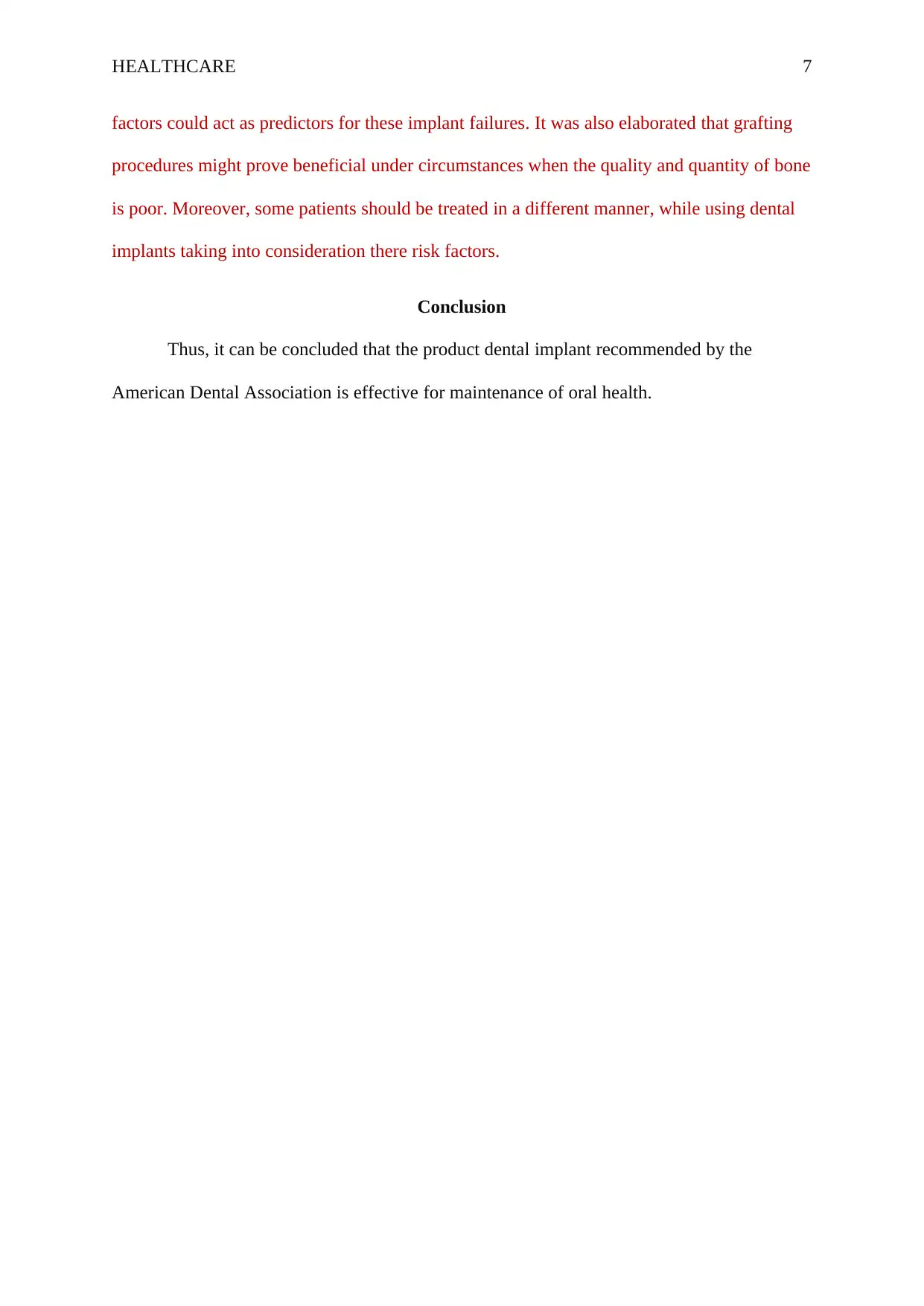
HEALTHCARE 7
factors could act as predictors for these implant failures. It was also elaborated that grafting
procedures might prove beneficial under circumstances when the quality and quantity of bone
is poor. Moreover, some patients should be treated in a different manner, while using dental
implants taking into consideration there risk factors.
Conclusion
Thus, it can be concluded that the product dental implant recommended by the
American Dental Association is effective for maintenance of oral health.
factors could act as predictors for these implant failures. It was also elaborated that grafting
procedures might prove beneficial under circumstances when the quality and quantity of bone
is poor. Moreover, some patients should be treated in a different manner, while using dental
implants taking into consideration there risk factors.
Conclusion
Thus, it can be concluded that the product dental implant recommended by the
American Dental Association is effective for maintenance of oral health.
Paraphrase This Document
Need a fresh take? Get an instant paraphrase of this document with our AI Paraphraser
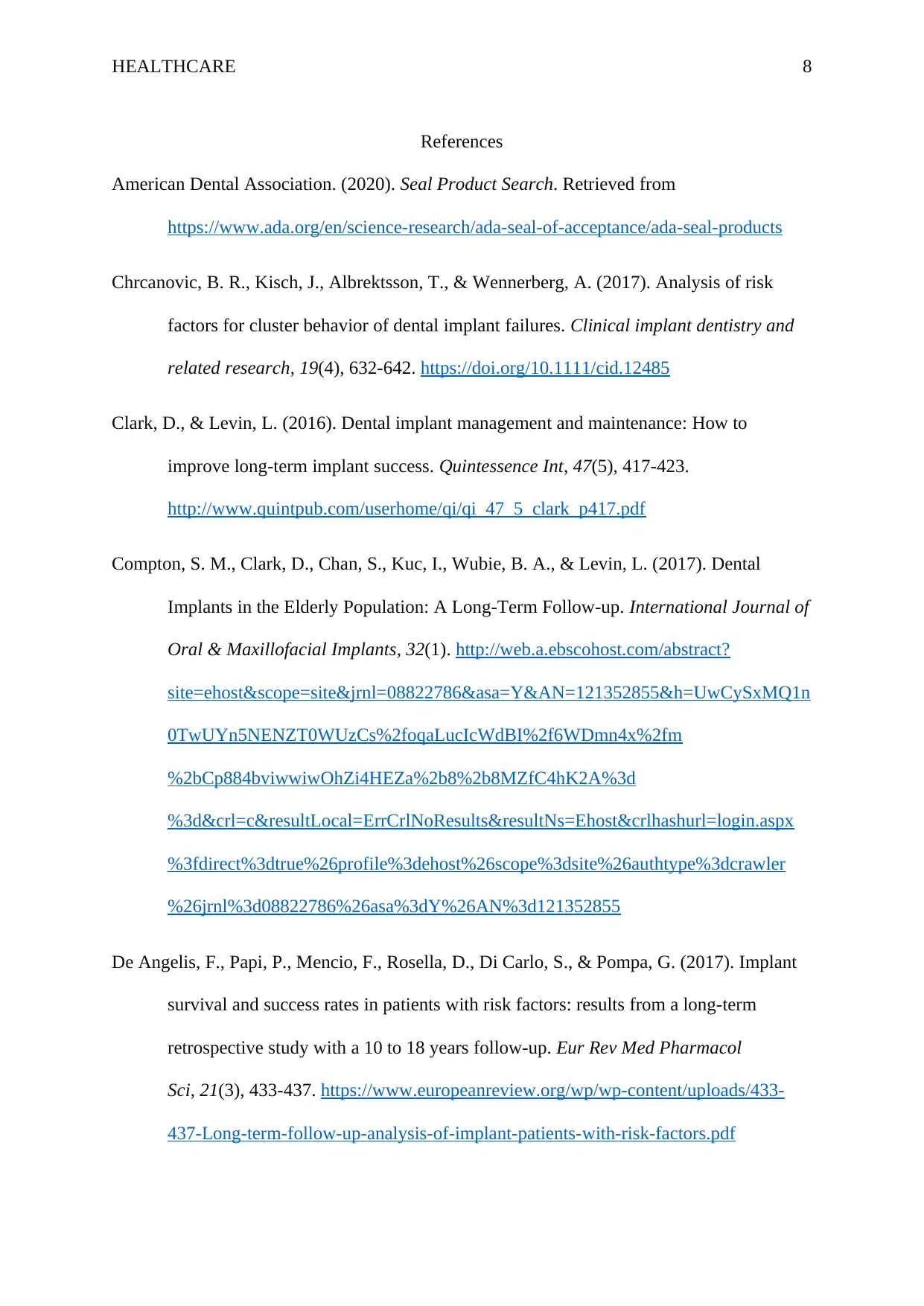
HEALTHCARE 8
References
American Dental Association. (2020). Seal Product Search. Retrieved from
https://www.ada.org/en/science-research/ada-seal-of-acceptance/ada-seal-products
Chrcanovic, B. R., Kisch, J., Albrektsson, T., & Wennerberg, A. (2017). Analysis of risk
factors for cluster behavior of dental implant failures. Clinical implant dentistry and
related research, 19(4), 632-642. https://doi.org/10.1111/cid.12485
Clark, D., & Levin, L. (2016). Dental implant management and maintenance: How to
improve long-term implant success. Quintessence Int, 47(5), 417-423.
http://www.quintpub.com/userhome/qi/qi_47_5_clark_p417.pdf
Compton, S. M., Clark, D., Chan, S., Kuc, I., Wubie, B. A., & Levin, L. (2017). Dental
Implants in the Elderly Population: A Long-Term Follow-up. International Journal of
Oral & Maxillofacial Implants, 32(1). http://web.a.ebscohost.com/abstract?
site=ehost&scope=site&jrnl=08822786&asa=Y&AN=121352855&h=UwCySxMQ1n
0TwUYn5NENZT0WUzCs%2foqaLucIcWdBI%2f6WDmn4x%2fm
%2bCp884bviwwiwOhZi4HEZa%2b8%2b8MZfC4hK2A%3d
%3d&crl=c&resultLocal=ErrCrlNoResults&resultNs=Ehost&crlhashurl=login.aspx
%3fdirect%3dtrue%26profile%3dehost%26scope%3dsite%26authtype%3dcrawler
%26jrnl%3d08822786%26asa%3dY%26AN%3d121352855
De Angelis, F., Papi, P., Mencio, F., Rosella, D., Di Carlo, S., & Pompa, G. (2017). Implant
survival and success rates in patients with risk factors: results from a long-term
retrospective study with a 10 to 18 years follow-up. Eur Rev Med Pharmacol
Sci, 21(3), 433-437. https://www.europeanreview.org/wp/wp-content/uploads/433-
437-Long-term-follow-up-analysis-of-implant-patients-with-risk-factors.pdf
References
American Dental Association. (2020). Seal Product Search. Retrieved from
https://www.ada.org/en/science-research/ada-seal-of-acceptance/ada-seal-products
Chrcanovic, B. R., Kisch, J., Albrektsson, T., & Wennerberg, A. (2017). Analysis of risk
factors for cluster behavior of dental implant failures. Clinical implant dentistry and
related research, 19(4), 632-642. https://doi.org/10.1111/cid.12485
Clark, D., & Levin, L. (2016). Dental implant management and maintenance: How to
improve long-term implant success. Quintessence Int, 47(5), 417-423.
http://www.quintpub.com/userhome/qi/qi_47_5_clark_p417.pdf
Compton, S. M., Clark, D., Chan, S., Kuc, I., Wubie, B. A., & Levin, L. (2017). Dental
Implants in the Elderly Population: A Long-Term Follow-up. International Journal of
Oral & Maxillofacial Implants, 32(1). http://web.a.ebscohost.com/abstract?
site=ehost&scope=site&jrnl=08822786&asa=Y&AN=121352855&h=UwCySxMQ1n
0TwUYn5NENZT0WUzCs%2foqaLucIcWdBI%2f6WDmn4x%2fm
%2bCp884bviwwiwOhZi4HEZa%2b8%2b8MZfC4hK2A%3d
%3d&crl=c&resultLocal=ErrCrlNoResults&resultNs=Ehost&crlhashurl=login.aspx
%3fdirect%3dtrue%26profile%3dehost%26scope%3dsite%26authtype%3dcrawler
%26jrnl%3d08822786%26asa%3dY%26AN%3d121352855
De Angelis, F., Papi, P., Mencio, F., Rosella, D., Di Carlo, S., & Pompa, G. (2017). Implant
survival and success rates in patients with risk factors: results from a long-term
retrospective study with a 10 to 18 years follow-up. Eur Rev Med Pharmacol
Sci, 21(3), 433-437. https://www.europeanreview.org/wp/wp-content/uploads/433-
437-Long-term-follow-up-analysis-of-implant-patients-with-risk-factors.pdf
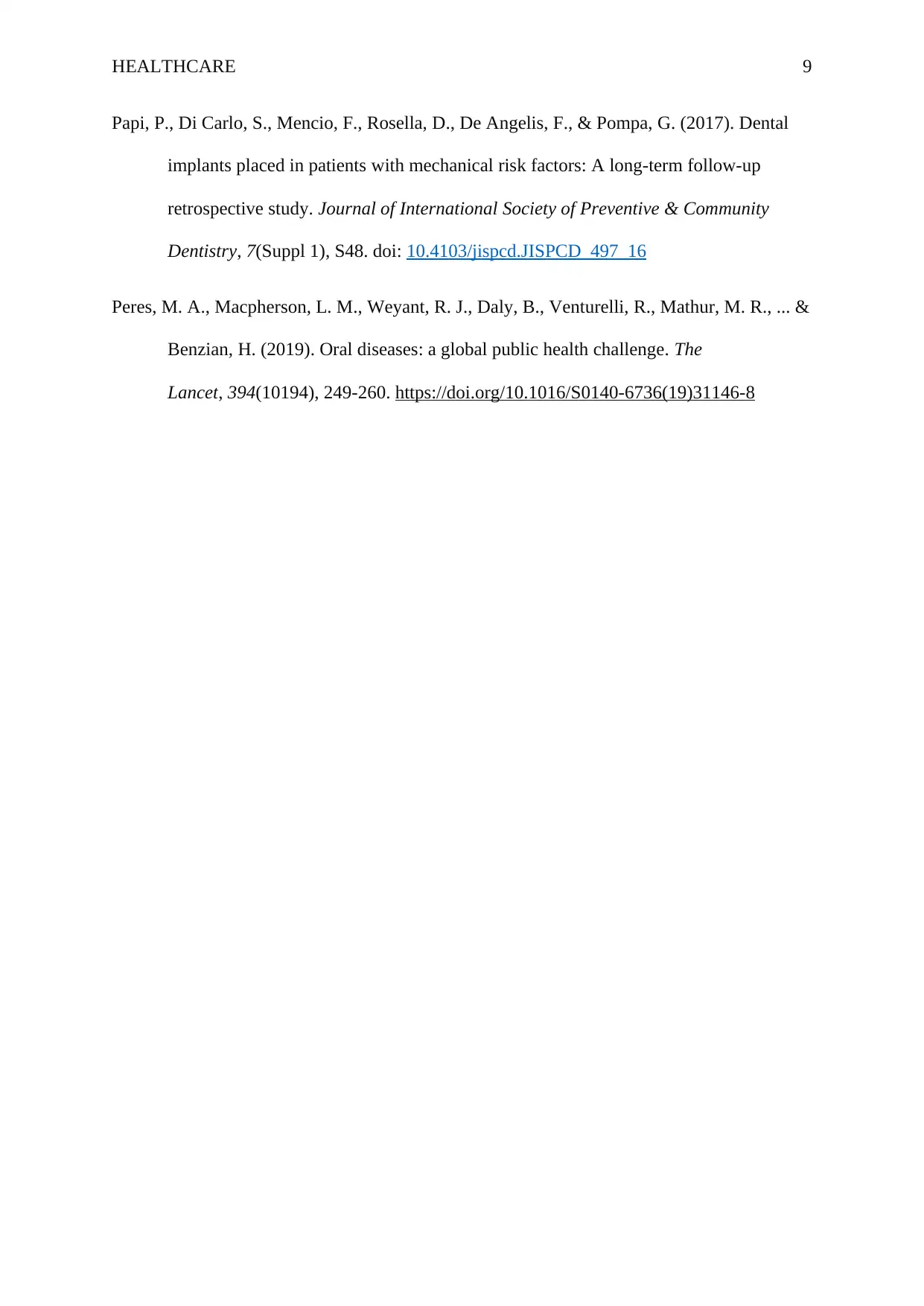
HEALTHCARE 9
Papi, P., Di Carlo, S., Mencio, F., Rosella, D., De Angelis, F., & Pompa, G. (2017). Dental
implants placed in patients with mechanical risk factors: A long-term follow-up
retrospective study. Journal of International Society of Preventive & Community
Dentistry, 7(Suppl 1), S48. doi: 10.4103/jispcd.JISPCD_497_16
Peres, M. A., Macpherson, L. M., Weyant, R. J., Daly, B., Venturelli, R., Mathur, M. R., ... &
Benzian, H. (2019). Oral diseases: a global public health challenge. The
Lancet, 394(10194), 249-260. https://doi.org/10.1016/S0140-6736(19)31146-8
Papi, P., Di Carlo, S., Mencio, F., Rosella, D., De Angelis, F., & Pompa, G. (2017). Dental
implants placed in patients with mechanical risk factors: A long-term follow-up
retrospective study. Journal of International Society of Preventive & Community
Dentistry, 7(Suppl 1), S48. doi: 10.4103/jispcd.JISPCD_497_16
Peres, M. A., Macpherson, L. M., Weyant, R. J., Daly, B., Venturelli, R., Mathur, M. R., ... &
Benzian, H. (2019). Oral diseases: a global public health challenge. The
Lancet, 394(10194), 249-260. https://doi.org/10.1016/S0140-6736(19)31146-8
⊘ This is a preview!⊘
Do you want full access?
Subscribe today to unlock all pages.

Trusted by 1+ million students worldwide
1 out of 9
Your All-in-One AI-Powered Toolkit for Academic Success.
+13062052269
info@desklib.com
Available 24*7 on WhatsApp / Email
![[object Object]](/_next/static/media/star-bottom.7253800d.svg)
Unlock your academic potential
Copyright © 2020–2025 A2Z Services. All Rights Reserved. Developed and managed by ZUCOL.

